The just-released report by a National Science Foundation task force signals a seismic shift in how — and where — U.S. astronomers will conduct their observations in the coming years.
A telling moment about the future of U.S. astronomy came last October. That's when James Ulvestad, who heads the astronomy division of the National Science Foundation, delivered a bleak budgetary forecast to the advisory committee that he relies on for programmatic guidance. Rather than growing, as it had for a decade, the federal funding for the country's national observatories and the community that depends on them was declining — with no real prospect for a short-term rebound.
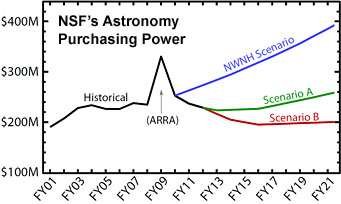
After many years of steady growth (boosted by American Recovery and Reinvestment Act funds), the U.S. National Science Foundation's budget has gone down recently — and might shrink further. It is unlikely to ever approach the levels envisioned by authors of the New Worlds, New Horizons decadal survey. More realistic are the optimistic and pessimistic scenarios shown in blue and red, respectively. (Dollars, in millions, have been adjusted to fiscal 2011.)
NSF
Everyone in the room knew what that meant. Just a year before, a much-ballyhooed vision for astrophysics in the coming decade had endorsed bold new ground-based initiatives like the Large Synoptic Survey Telescope (LSST) that would maintain and extend U.S. leadership in astronomy. But to afford them, the panel of experts who crafted the 300-page road map (titled New Worlds, New Horizons in Astronomy and Astrophysics) had assumed an undeniably rosy budget growth of 4% per year. Clearly, that was not happening. So, to be able to afford even some of marquee ground-based facilities called for in NWNH, astronomers would need to tighten their collective belts elsewhere.
Now, we know where those cuts will likely occur. Last week a 17-member task force, led by Harvard cosmologist Daniel Eisenstein, released its analysis of what the NSF can likely afford in the years ahead. Unlike a similar tough-love assessment conducted in 2006, this "portfolio-review" committee looked at everything — not only the construction and operation of facilities at national observatories but also the money needed to fund investigator grants, develop new instrumentation, and support relevant theoretical, computational, and laboratory capabilities.
In the simplest terms, Eisenstein's group had to figure out what capabilities would be needed to achieve the highest-priority scientific objectives spelled out in NWNH (it wasn't allowed to second-guess those), and then optimize the NSF's investments accordingly. There were winners and losers, and I'll detail those in a moment. (In fact, you can freely download the full report, titled Advancing Astronomy in the Coming Decade: Opportunities and Challenges.) But first here's a quick overview of the larger forces driving modern-day America's astronomical research.
The NSF underwrites four federally funded facilities that provide unrestricted access to all U.S. astronomers:
- National Optical Astronomy Observatory, responsible for several optical telescopes atop Kitt Peak in Arizona as well as Cerro Tololo Inter-American Observatory and the SOAR telescope in Chile (NSF budget in fiscal 2012: $26.1 million);
- National Solar Observatory, which manages big sunwatching telescopes on Kitt Peak and on Sacramento Peak in New Mexico, as well as the forthcoming Advanced Technology Solar Telescope in Hawaii ($11.1 million);
- National Radio Astronomy Observatory, responsible for the massive Green Bank Telescope as well as the Very Large Array and Very Long Baseline Array; also operates the Atacama Large Millimeter/submillimeter Array (ALMA) in partnership with others ($71.7 million); and
- Arecibo Observatory, the world's largest and most sensitive radio telescope, in Puerto Rico ($5.5 million).
Many countries, even small ones like Greece and Panama, have national observatories. The idea for one in the U.S. gained traction during the 1950s and early 1960s, in response to the dominance of private facilities (Palomar and Lick, for example) that denied access to astronomers at small, unaffiliated institutions. For optical work, the construction of Kitt Peak National Observatory southwest of Tucson finally gave these have-nots dependable access to first-rate telescopes. This open-access model, eventually expanded to the solar and radio domains, worked well through the 1990s.
But the soaring cost of today's superscopes — Keck and Gemini come to mind — has again required partnerships not just between major universities but also among multiple countries. "Big observatories and big science instruments are becoming international," Ulvestad says. Take, for example, the Gemini telescopes, twin 8-meter behemoths in Hawaii and Chile. Although owned by NSF, they've been built and managed jointly with Canada, Chile, Australia, Brazil, and Argentina. (A seventh partner, the United Kingdom, recently chose to withdraw.)
Staying Competitive, Staying Alive
Even as construction bills continue to pile up for the billion-dollar ALMA array and the ATST, U.S. astronomers are already dreaming about LSST and the proposed Cerro Chajnantor Atacama Telescope, which aren't even in the budget yet.
But they likely will be, so to create some budgetary breathing room Eisenstein and his committee prioritized NSF's astronomy assets with an eye toward identifying existing facilities that could — and should — be "divested" by 2017. And why that date? It's basically a "count-back," Ulvestad explains: if NSF cuts off funding for a particular telescope and can't find someone to take it over, then the costs to close it down have to be spread over a few years.
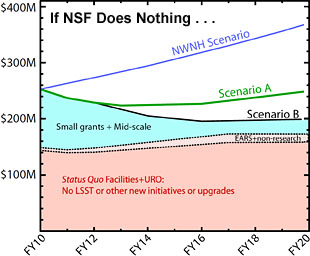
Given the current economic climate, the National Science Foundation should expect a rather bleak budgetary outlook for its astronomy programs — at least in the short term. (Dollars, in millions, are adjusted to fiscal 2011.) In that case, even if it spends nothing on upgrades or new facilities, the cost of operating all of its existing facilities might gradually squeeze out most of the money being given to observers as grants.
NSF
The panel worked with two possible funding paths: an optimistic Scenario A envisions a return to modest growth beginning in fiscal 2014, and a pessimistic Scenario B assumes a 3% drop for two years, flat funding in fiscal 2015 and 2016, and 3% annual growth thereafter. "Either scenario requires aggressive action on divesting the less-critical facilities in the [NSF astronomy] portfolio," the committee concludes. Because federal dollars for science could become even scarcer after November's elections, the review committee assumed the bleaker funding profile.
"It's a very sobering thing to look at the budget," observes Eisenstein. "When it drops by 20%, that's going to cause reductions — and ultimately many peoples' jobs." With that in mind (and following NWNH's lead), the committee recommends a strong commitment to continued NSF funding of grants to individual investigators and to instruments, surveys, and experiments in the $3-to-$50-million range.
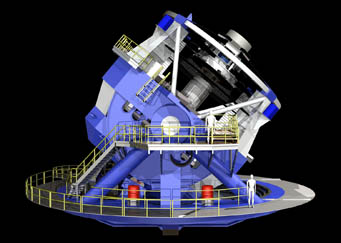
An August 2010 rendering of the Large Synoptic Survey Telescope, which was ranked highest in priority by the NRC's decadal-survey committee.
LSST Corp.
At the other end of the project spectrum were recommendations to start construction of the LSST as soon as possible, and to provide funding for both the CCAT and a Giant Segmented Mirror Telescope (GSMT). The committee also gave thumbs up to continued funding of ALMA, ATST, the Very Large Array, both Gemini telescopes, and NOAO's two 4-meter telescopes in Chile. Arecibo made the cut too — despite being threatened with closure after the 2006 assessment.
With all that on the table, something had to give. In both funding scenarios, the committee felt NSF should stop underwriting three optical telescopes on Kitt Peak (including the 4-m Mayall reflector), the nearby McMath-Pierce Solar Telescope, the Green Bank Telescope in West Virginia, and the globe-spanning Very Long Baseline Array.
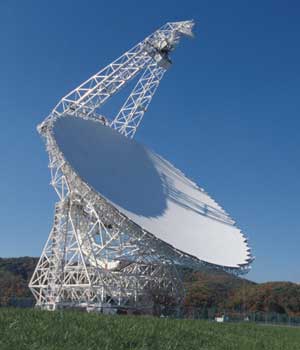
The world's largest fully steerable radio telescope is the Robert C. Byrd Green Bank Telescope (GBT) in West Virginia. The dish measures 100 by 110 meters.
NRAO / AUI
Managers at NRAO and at Associated Universities, which operates the radio facilities on the hit list, were quick to offer their take on the situation. "[We] recognize and acknowledge the need to retire obsolete facilities to make way for the state-of-the-art," they note in a joint AUI-NRAO statement. "However, both the GBT and the VLBA are the state-of-the-art, and have crucial capabilities that cannot be provided by other facilities."
The portfolio-review committee counters that its choices were not really statements about the quality of science being conducted but instead how well each facility fit into the grand scheme put forward in the decadal survey. So, for example, NOAO's 4-m Blanco telescope in Chile was spared — and its twin on Kitt Peak was not — both because the southern sibling is about to undertake a five-year Dark Energy Survey and because it can ultimately follow up discoveries made by LSST, which will be sited in Chile.
Understandably, many astronomers are shocked and saddened by the committee's choices. (Read a sampling of the outrcy.) While the McMath solar telescope was to be phased out anyway (though not so soon) to make way for ATST, seeing the Green Bank Telescope on the list was unexpected. After all, it's the largest fully steerable radio antenna in the world — and it's only 10 years old.
The potential loss of the three "small" reflectors on Kitt Peak pose a different kind of problem, one that will make it harder for young postdocs and graduate students to get real-world observing experience. Eric Perlman (Florida Institute of Technology) fumes, "It is simply not acceptable to cut off the community’s access to midsize optical telescopes, as well as the GBT and VLBA. This is why the National Observatories were created, and the reasoning is just as valid today as it was 50 years ago."
Howard Bond, formerly at the Space Telescope Science Institute, makes this analogy: "Those of us who use KPNO are apparently being told to give up our nice reliable Chevy, and in 10 years we will get (part of) a beautiful Mercedes-Benz. But in the meantime we won't be able to get to work."
The Association of Universities for Research in Astronomy, which operates NOAO, Gemini, and NSO, released a statement on August 22nd. "We share the goals of the Portfolio Review to develop a balance between grants and facilities, and between existing facilities and advanced future capabilities," it states, while expressing concern about the "potential loss of science" due to the proposed cutbacks.
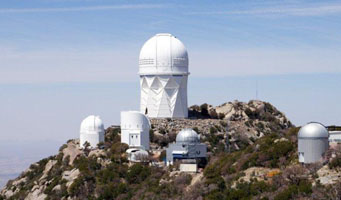
The 4-meter Mayall Telescope dominates the skyline of the Kitt Peak National Observatory.
Govert Schilling
So what does Timothy Beers, who took over as Kitt Peak's director only last year, think of all this? First, he's puzzled. "They're going to trade away 700 to 1,000 observing nights per year to liberate funds for future projects — and that is a real change of pace."
But Beers remains optimistic that the summit's big eyes will carry on in some capacity. "We're not planning on closing KPNO but rather to reconfigure it," he explains. "We await some yet-to-be-negotiated set of plans as to what to do." The big Mayall reflector, for example, could be salvaged if astronomers at Lawrence Berkeley National Laboratory use it to undertake their proposed BigBOSS dark-energy survey.
We've not heard the last of this emotional debate. "We've gotten some advice, and we'll make some recommendations," Ulvestad told me. But larger forces — within the NSF, the next president's administration, and the Congress — will dictate the final outcome. "This is the start of a very long process," he says, "and I can't predict where it's going."
 9
9
Comments
Pat
August 24, 2012 at 12:29 pm
This is very sad. Science is under attack on all fronts, by zealots and bean counters, and we're heading back to the Dark Ages (literally and figuratively).
You must be logged in to post a comment.
Russ Stern
August 24, 2012 at 1:46 pm
As Pat said. The wrath of organized cults is destroying Americas science - FULL STOP.
Sagan was aware of the trend, he wrote of this in his 'Demon Haunted World'. We've been to the Moon. That too was quickly swept into the dustbin. The SSC - dumped. The shuttle.. they are hot to close Fermilab.. I can hardly write this, I've written so many articles concerning our plight. The media have shunted the populace into a closed arena. There are no science writers. They were tossed. We see garbage, read garbage. The young babble away about 'zombies' and vampires', while they curse a streak of trash - vulgar and insipid too. The America of JFK era was on a path to further education, science and discovery. We are so entirely removed from that - it is beyond explaining to the youth of today.
We are well into the 'new' dark age.
You must be logged in to post a comment.
Anthony Barreiro
August 24, 2012 at 3:30 pm
Thanks Kelly for this clear, if discouraging, report on the immediate future of federal funding for the astronomical alphabet-soup of telescopes and research grants. These are indeed challenging times. I find the lazy excuse of "the current economic climate" particularly frustrating. Large financial corporations and a few thousand wealthy individual Americans have more money than ever before in history. Thirty years of tax cuts and reckless military spending have driven the federal budget into deep deficits and have destroyed the social contract that held this country together and helped us get to the Moon. Scientific progress and real democracy depend on those with the means paying their fair share. Private philanthropy is never going to be enough to maintain a national and international scientific infrastructure.
You must be logged in to post a comment.
SpaceNut Jon
August 24, 2012 at 9:26 pm
I hope we all remember this November where the money went!
Instead of scientific and educational goals, the bucks went to entitlements and stimulus(es), to foreign entities and and just plain blown.
When Obama cut the shuttle program without a viable alternative other than hitching a ride with our quasi partner- the Russkies- I knew that Science and technology was doomed! That's some forethought! ...and it starts with the media's ignorance
The dumbing down of America began with a bloated educational system that would rather pay for perks, teacher's unions and trophies for everyone rather than reading, writing and science/math. We need to reestablish our priorities before we become a 3rd world in science and research. There's no shame in American exceptionalism and pride.
You must be logged in to post a comment.
John
August 25, 2012 at 12:07 pm
It's no surprise to me. Several years ago I had to get my graduate degree in astronomy in Australia. Then my funding got cut off (was a federal employee) just before I could finish my PhD and I had to withdraw from the program. I've tried to find funding to no avail.
It's a travesty for either the President and/or Congress to shoot future scientist in the foot with cuts to funding these important investments in the country's future.
I think Kitt Peak should be used as an educational institution giving access to college students. Why do the powers to be insist on putting our assets in foreign countries?
We need to elect members of Congress and a President who are scientists.
You must be logged in to post a comment.
NS
August 26, 2012 at 3:22 pm
30 + years of rhetoric about how government is the problem and how we should cut federal spending, and it surprises people that the first things to be cut are telescopes. Get real. Big government pays for science, and the means of payment are deficit spending and/or taxes on people with a lot of money to spare -- the wealthy. The welfare state argument is bogus. Almost all money given to the poor and middle class comes right back into the economy as spending, and hence jobs/prosperity. It's money given to the wealthy (e.g. in tax cuts) that often just sits there as numbers in a bank account. Tax the rich, spend more on the rest of us, and we'll have a prosperous society that has money to spare for science.
You must be logged in to post a comment.
Peter
August 27, 2012 at 4:52 pm
The wheels turn, pendulums swing, and seasons come and go. The summer of ever expanding budgets is over; winter is on its way. We are facing limits in a paradigm of unlimited growth. It is no longer a fight over who gets the most, but who gets cut the least, so it’s bound to turn ugly. If you want to understand why so few scientists are in congress, try running for office.
You must be logged in to post a comment.
HP Miller
August 29, 2012 at 8:48 pm
NSO / ATST is relocating its Headquarters from Tucson, AZ to Boulder, CO. The PR Committee report didn't mention that. I wonder how much this will cost AST, and is it worth having to close other productive telescopes to pay for it?
You must be logged in to post a comment.
Jay
August 31, 2012 at 10:57 am
The current administration says STEM is a priority, and the graph in this article shows the strongly positive effect of the 2009 A.R.R.A “stimulus” on these specific NSF astronomy programs.
It seems pretty far-fetched to suggest that the present-day right wing politicians, who’ve been gutting science education and revising history books state-by-state, will save STEM funding in America.
I would like to see more funding for astronomy, space, and all forms of science education and research, and I put my volunteer time and occasional letter where my mouth is on that belief. I don’t think changing horses in November will revive STEM, more likely it would do the contrary…
You must be logged in to post a comment.
You must be logged in to post a comment.